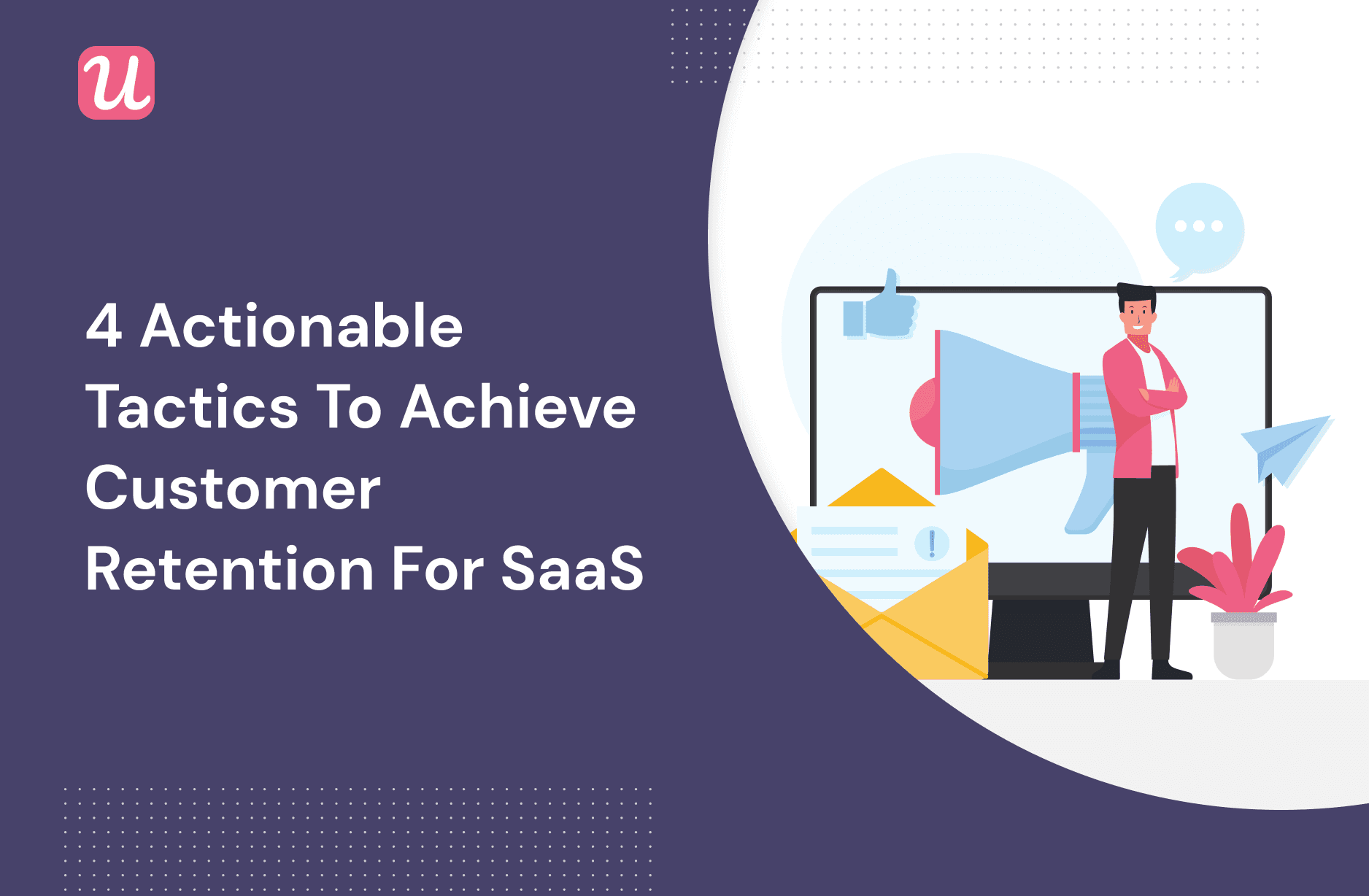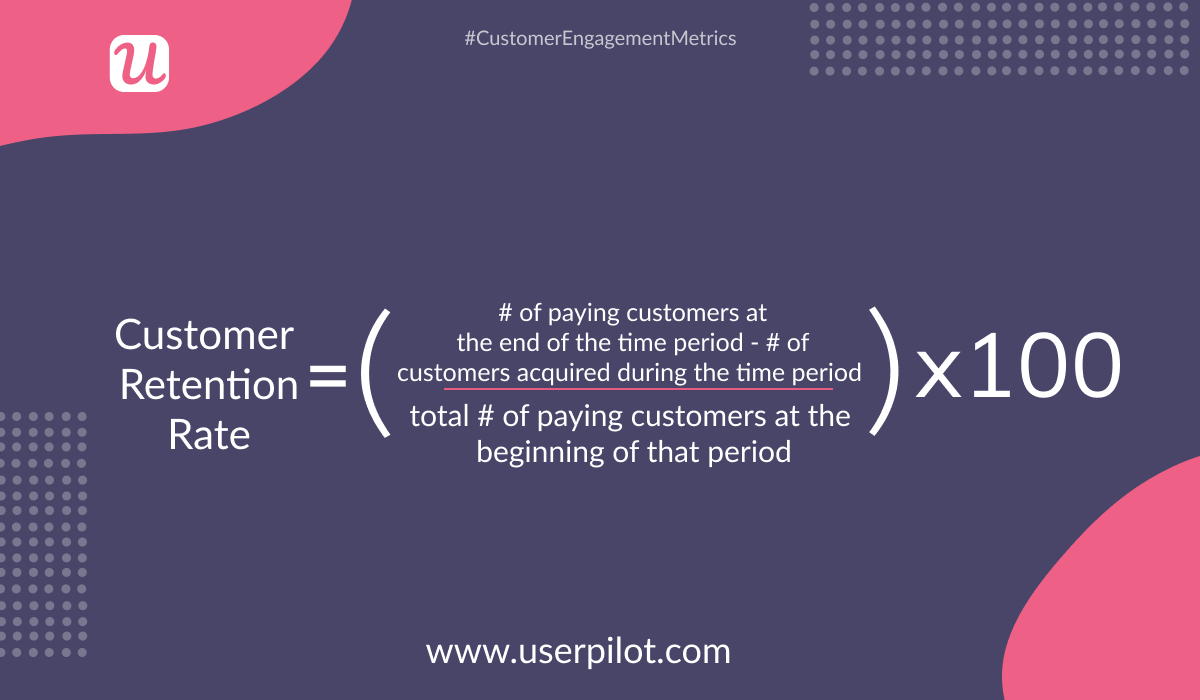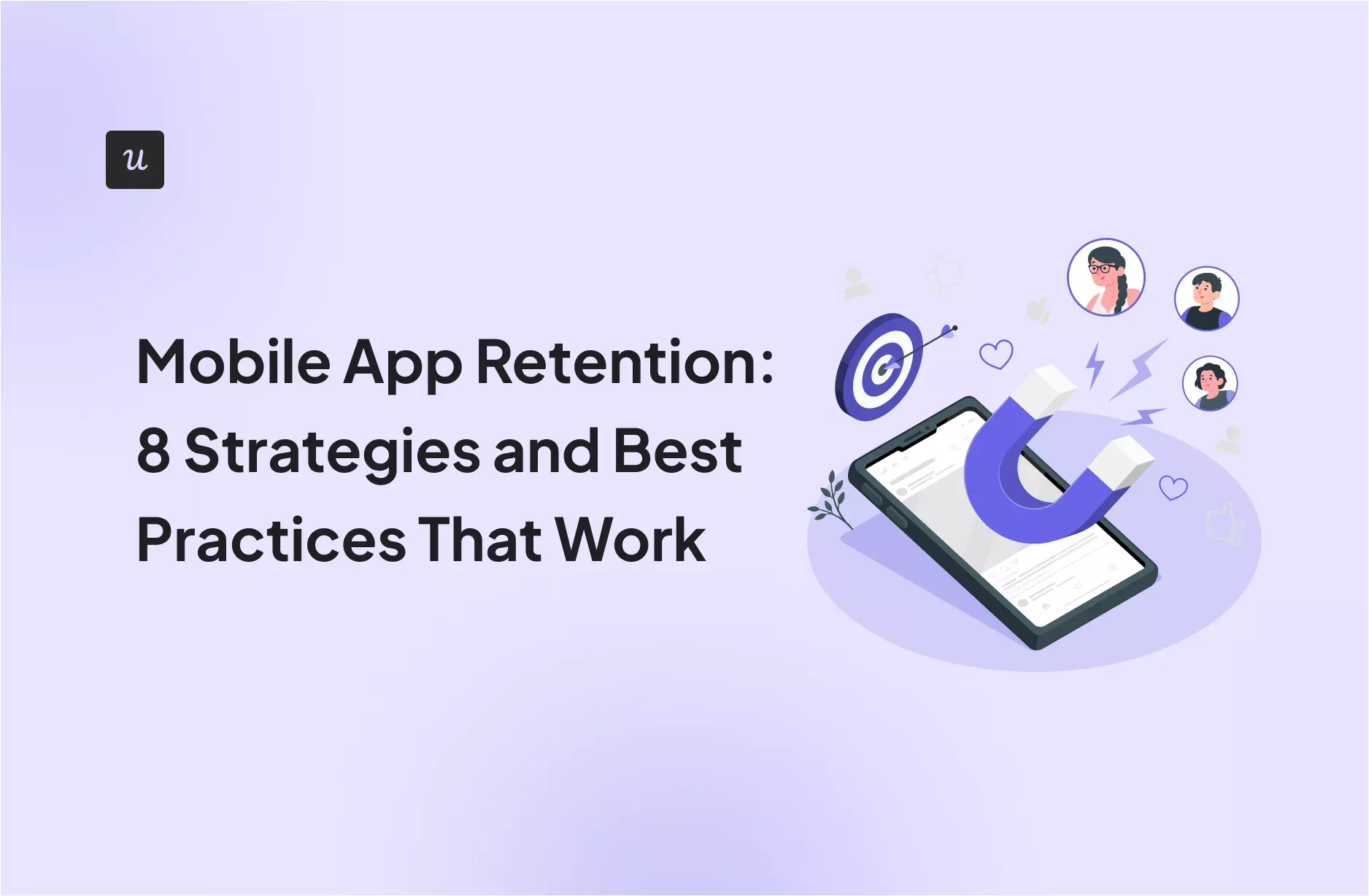
4 Actionable Tactics To Achieve Customer Retention For SaaS
[vc_section][vc_row][vc_column][vc_column_text]
Have you run out of ways to achieve customer retention for your SaaS business?
Customer retention gives SaaS companies a competitive advantage, especially with a subscription-based pricing model. As you retain customers, they become more likely to upgrade to higher-tiered subscriptions and even become loyal brand advocates.
In SaaS, 40% of growth comes from word-of-mouth marketing by existing customers, and many businesses earn up to 35% of their yearly contract values from upsells.
Let’s find out 4 actionable tactics, as well as some key customer retention metrics, to win your users’ loyalty and improve retention.
Get The Insights!
The fastest way to learn about Product Growth, Management & Trends.
TL;DR
- Customer retention rate measures the percentage of customers who stick with your business over a period of time.
- Set a period over which you want to measure your retention rate based on drop-offs in returning users.
- Retention gives you a clear understanding of customer loyalty and translates into increased customer lifetime value and profitability.
- A retention rate of 35% and above is great for a SaaS business. As the definition of retention is based on the health of companies, no two businesses will have the same acceptable range for retention rate.
- Tracking a combination of retention metrics helps you identify and mitigate gaps in customer experience.
- Actionable retention tactics will help make revenue more predictable and maximize the number of repeat customers.
- Personalize your secondary onboarding process to constantly provide value to your customers and help them shift to paid-pros.
- Use NPS surveys to gather both qualitative and quantitative feedback on customer satisfaction with your product or service.
- Satisfy your customers by providing self-service support so they can quickly find the answers they’re looking for.
- Short churn surveys are a great way to know why your customers are leaving and perhaps even encourage them to stay back.
What is the customer retention rate?
Customer Retention Rate measures the percentage of customers who stick with your business over a period of time. In fact, it is one of the most important customer retention metrics.
Simply put, customer retention rate essentially measures how many users you’ve retained over a given period. Retained users are repeat customers who were active subscribers during a particular period and then resubscribed to your product in the next billing cycle.
How do you measure customer retention rate?
First, you have to determine the time frame for measuring retention. It’s common for apps to track this metric at various periods, such as two-week, one-week, and one-day retention.
Your product team should set the time frame based on where there are drop-offs in returning customers.
To calculate the retention rate use this formula:
Let’s assume you’re measuring the rate quarterly and onboarded 1000 customers on 1st January. By the end of that quarter, 250 of those were no longer customers but you also acquired 500 new customers, leaving you with 1250 customers.
Your retention rate = ((1250 – 500)/1000) * 100 = 75%.
Why is customer retention important?
To apply retention tactics, you first need to understand how important retention is.
Retention determines how good you are at keeping existing customers happy as well as acquiring new ones. It gives you a clear understanding of brand loyalty.
Customer retention is where your SaaS business will make money. According to Harvard Business Review, it’s 5-25 times more expensive to gain a new customer than keep an existing customer.
When customers drop off before completing enough payment cycles, it gets difficult to reach an ideal ratio between the customer lifetime value (CLV) and customer acquisition cost (CAC).
However, with loyal customers, it becomes easier to ask for more money from existing customers and get new ones simultaneously.
What is a good customer retention rate in SaaS?
A Mixpanel report stated a retention rate of 35% and up, measured over 8 weeks, is great for a SaaS business. Most software and apps have a 6-20% eight-week retention rate based on their industry.
However, the definition of retention differs from business to business. No two customer bases, products, or business methodologies are the same. Sometimes, these differences are quite obvious, whereas, at other times, they can be negligible.
Suppose two companies may have identical business models and almost the same number of users gained and lost. One may still have a retention rate of 90%, while the other stands at 76% simply because they have different definitions of retention.
On the other hand, the customer acquisition method of company A may involve multi-year contracts, while that of company B includes no commitment. If A sees limited user activity for several months, it may not be a warning sign. However, if B’s customers don’t come back after a day, they may be at risk of churning.
Therefore, to understand whether your retention rate is good or bad, your product team should define retention based on the health of your business.
What are the benefits of customer retention?
Customer retention is crucial to your SaaS company’s success. Some of its key benefits include:
- Less expensive than acquiring new customers.
- Increased customer loyalty and word-of-mouth referrals.
- Higher profits through account expansion opportunities via upsells, cross-sells, and add-ons.
- Increased customer lifetime value.
What are the key metrics to measure customer retention?
Retention is imperative for the survival of any SaaS business, but it’s also important to track the metrics that affect it. These metrics let you understand existing and potential gaps in customer experience and mitigate them quickly to drive growth.
One single retention metric is unlikely to give you all the information you need. The best metrics depend on your business goals, such as profitability, growth, and maximizing average revenue per user. So, it’s almost always necessary to look at several customer retention metrics together.
For more information, we’ve also covered retention analytics which examines data from multiple customer segments to understand factors that drive retention.
The 5 most important customer retention metrics are:
- Customer Churn Rate (CCR)
- Customer Lifetime Value (CLV)
- Monthly Recurring Revenue (MRR)
- Customer Acquisition Cost (CAC)
- Customer Engagement Score (CES)
Customer Churn Rate
The customer churn rate reflects the percentage of customers who leave your service over a given period.
It’s one of the key metrics since it allows you to understand how customers are leaving, why they’re leaving, and where in the funnel they’re leaving.
So, by tracking CCR, you can build more well-designed product experiences to reduce churn rate and boost retention rate. It also helps you develop potential retention strategies that align with your business goals.
How to measure customer churn rate
Again, you need to determine the period for measurement. Most SaaS companies prefer to do this on an annual, monthly, or weekly basis to get the full picture of what’s going on in the business.
The churn rate is equal to the number of users churned during the set period divided by the number of users present at the beginning of that period, multiplied by 100.
From the previous example for retention, the number of users lost is 30. Hence, the churn rate is:
(30/80) x 100 = 37.5%

Monthly Recurring Revenue
Monthly recurring revenue is the sum of money you can expect to earn every month from your active subscribers. It helps to predict future cash flows and how much profit you’ll likely make.
MRR is a characteristic of a subscription-based business model. Tracking this metric over time lets you determine where your users are achieving customer success with your product.
How to measure Monthly Recurring Revenue
To calculate your MRR, simply multiply your total number of paying customers by the average revenue per user (ARPU).

Customer Lifetime Value
Most of the profits in SaaS come from repeat subscriptions and not just a single transaction. Customer Lifetime Value (CLV) projects how much revenue an average customer will bring your business throughout their interaction with your product.
CLV helps you improve the overall profitability of your business. The longer you retain customers, the more you earn per subscription, and the lower your costs per user, the higher your LTV.
How to measure Customer Lifetime Value
Customer lifetime value equals your average revenue per account (ARPA) divided by your churn rate.
By calculating LTV, you can project future investments and revenues.

Customer Acquisition Cost
Customer acquisition cost (CAC) is a measure of how much you spend to get new customers into the funnel. It helps you decide the amount you should spend on sales and marketing campaigns.
How to measure Customer Acquisition Cost?
To calculate CAC, add all your marketing and sales costs over a particular period, monthly or annually, and divide the value by the number of new customers acquired during that period.

Customer Engagement Score
The customer engagement score reflects how engaged each of your existing users and free trial users is with your product. Every user’s level of engagement is signified by a score based on inaction or action.
Healthy and happy customers tend to have a higher engagement score as opposed to disengaged and unhealthy ones.
You can use the engagement scores to take advantage of business opportunities by customizing your in-app experiences and messaging to the needs of specific segments.
How to measure customer engagement score
To calculate the customer engagement score, add the total event value for every customer. Total event value equals the event importance on a scale of 1 to 10, multiplied by the frequency of that event in the last X days.

4 actionable tactics to improve customer retention
Now that you know how crucial customer retention is in SaaS and the metrics you need to monitor to drive it, you need to bring your retention strategies to life.
Retention management involves using tactics that help build strong customer relationships to maximize retention and make revenue more predictable.
These 4 actionable tactics here will help you achieve customer satisfaction by making sure customers meet their desired outcomes by using your product.
Additionally, you should use retention tools and software to implement your tactics effectively.
#1 – Act on NPS feedback to improve customer retention
The Net Promoter Score (NPS) is a survey based on a scale of 0-10 to measure customer loyalty with your product or service. It’s a useful measure of customer satisfaction.
NPS will help you find out whether:
- Your customers are facing problems that might cause churn
- Customers are finding your product features valuable
- Your product is serving customers’ needs
You can create and send an NPS survey using Userpilot. It shows up in-app, so users are more likely to respond. Moreover, you can segment users to make the survey appear in front of a specific customer group.
The question goes something like the one shown below.

Why should NPS surveys end with a follow-up question
Simply having the average NPS score won’t tell you much about user experience. You need to send customers a follow-up question to know what they love about you and what they don’t.
This way, you can build up on your strength as well as address customer issues.
This way, you can collect valuable qualitative feedback to decrease churn and increase customer retention for your SaaS business.

Promoters are users who give you a score of 9 or 10. They are your loyal customers, so you can ask them for reviews or case studies to provide evidence for marketing campaigns.
Detractors are those who give a score of 6 or less. You need to ask what they are so unhappy about with your product since they are in danger of churning. You can resolve their problems to avoid churn.
Passives give you a score of 7-8, and following up with them can help you understand whether you can approach them with add-ons and upgrades.
#2 – Increase retention rate with a personalized secondary onboarding process
You are not done with your onboarding flow once you reach user activation. Secondary onboarding is crucial to retention as customers have to be constantly educated to get more and more value from your product over time.
It’s crucial to include onboarding activities at every stage of the user journey.
Hence, you need primary onboarding, secondary onboarding, and tertiary onboarding for the following product growth goals.

These are the UI elements you need to include in your onboarding process:
- Checklists
- Support Center
- Native tooltips
- Experience flows
Why use in-app messages for secondary onboarding?
In-app messaging is a compelling part of secondary onboarding. It lets you solve problems customers seem to be experiencing and point them to solutions and features that are most likely to bring them value.
In-app messaging helps guide customers at different stages of the user journey. You can use it to:
- Provide in-app guidance to onboard users more effectively.
- Gather customer feedback.
- Stimulate feature adoption and account expansion.
- Send notifications about announcements and updates.

#3 – Provide in-app support to educate your customers
81% of software users would prefer trying and solving problems on their own before reaching out for help. That said, don’t force them to ask when they don’t want to!
Self-service support includes help-centers, FAQ and training documents, contextual onboarding experiences, interactive walkthroughs, among others.
Let’s say you’re visiting a social media scheduling website and got stuck on scheduling posts for Instagram.
You could check the knowledge base, browse some articles, maybe Google it, and you may find what you want eventually. Still, you’ll have to go back to the site and implement what you’ve learned.
Notice how this process involves a lot of friction.
Instead, help centers can turn this 15-minute task into a 1-minute one.
What are the benefits of in-app resource centers?
Your customer support team is always busy, and so are your customers. None of us like complex products that consume too much of our time.
Having in-app resource centers helps:
- Collect and display all your resources in only one place.
- Decrease the volume of support tickets.
- Save your customers’ time because they can find answers to their queries without leaving the app.

Want to build one without coding? Get a Userpilot demo and see how.
#4 – Improve customer retention with churn surveys
Churn surveys (also known as exit surveys, customer loss surveys, or cancellation surveys) are a subset of micro surveys. They contain short questions sent after a customer decides to downgrade or cancel their subscription plan.
Make sure you don’t turn a churn survey into a questionnaire. This avoids friction in the churning process by not taking too much of the customers’ time.
There are 3 types of churn surveys:
- Open-ended questions
- Multiple-choice questions
- Mixed questions.
Below, you can see an example of a mixed questions survey to not miss out on any potential customer concerns. Keep the response box for open-ended questions optional since your main goal is to get answers to the multiple-choice question.

Should you use in-app or email churn surveys?
There are 2 main ways of collecting customer feedback via churn surveys – in-app or email. You can use marketing automation tools to trigger both of them automatically.
Now, which one should you use?
In-app churn surveys are contextual. They get displayed right after a user clicks on the cancelation button that can increase:
- The chance of the user changing their mind – by showcasing what they’ll miss out on if they cancel.
- Completion rate – unlike emails that may get lost in the inbox, a user can’t miss in-app surveys.
Key takeaways
Customer retention is imperative for SaaS companies. Although it’s exciting to gain new customers, it’s simply too expensive to lose existing ones.
To keep your customers satisfied, get to know them better through NPS and churn surveys and guide them in their journey through in-app resource centers and smooth onboarding.
To boost your customer retention, get a Userpilot demo and start right away.
[/vc_column_text][/vc_column][/vc_row][/vc_section]








